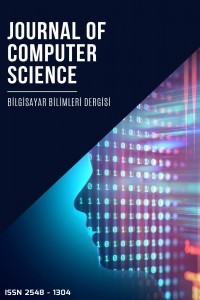Çoklu Nesne Takibi FairMOT Algoritması İçin Optimizasyon Algoritmalarının Karşılaştırılması
Çoklu Nesne Takibi, Optimizasyon Algoritmaları, FairMOT
Comparison of Optimization Algorithms for Multi-Object Tracking FairMOT Algorithm
FairMOT, Multi-Object Tracking, Optimization Algorithms,
___
- America, N. E. C. L. and Nj, P. (2010) ‘Large-Scale Machine Learning with Stochastic Gradient Descent (SGD)’, Proceedings of COMPSTAT’2010, pp. 3–4. doi: 10.1007/978-3-7908-2604-3.
- Bernardin, K. and Stiefelhagen, R. (2008) ‘Evaluating multiple object tracking performance: The CLEAR MOT metrics’, Eurasip Journal on Image and Video Processing, 2008. doi: 10.1155/2008/246309.
- Dendorfer, P. et al. (2020) ‘MOT20: A benchmark for multi object tracking in crowded scenes’, arXiv, pp. 1–7.
- Girshick, R. et al. (2014) ‘Rich feature hierarchies for accurate object detection and semantic segmentation’, Proceedings of the IEEE Computer Society Conference on Computer Vision and Pattern Recognition, pp. 580–587. doi: 10.1109/CVPR.2014.81
- Girshick, R. (2015) ‘Fast R-CNN’, Proceedings of the IEEE International Conference on Computer Vision, 2015 Inter, pp. 1440–1448. doi: 10.1109/ICCV.2015.169.
- Kingma, D. P. and Ba, J. L. (2015) ‘Adam: A method for stochastic optimization’, 3rd International Conference on Learning Representations, ICLR 2015 - Conference Track Proceedings, pp. 1–15.
- Leal-Taixé, L. et al. (2015) ‘MOTChallenge 2015: Towards a Benchmark for Multi-Target Tracking’, pp. 1–15. Available at: http://arxiv.org/abs/1504.01942.
- Lin, T. Y. et al. (2014) ‘Microsoft COCO: Common objects in context’, Lecture Notes in Computer Science (including subseries Lecture Notes in Artificial Intelligence and Lecture Notes in Bioinformatics), 8693 LNCS(PART 5), pp. 740–755. doi: 10.1007/978-3-319-10602-1_48.
- Milan, A. et al. (2016) ‘MOT16: A Benchmark for Multi-Object Tracking’, pp. 1–12. Available at: http://arxiv.org/abs/1603.00831.
- Redmon, J. et al. (2016) ‘You only look once: Unified, real-time object detection’, Proceedings of the IEEE Computer Society Conference on Computer Vision and Pattern Recognition, 2016-Decem, pp. 779–788. doi: 10.1109/CVPR.2016.91.
- Ren, S. et al. (2017) ‘Faster R-CNN: Towards Real-Time Object Detection with Region Proposal Networks’, IEEE Transactions on Pattern Analysis and Machine Intelligence, 39(6), pp. 1137–1149. doi: 10.1109/TPAMI.2016.2577031.
- Riedmiller, M. and Braun, H. (1993) ‘Direct adaptive method for faster backpropagation learning: The RPROP algorithm’, 1993 IEEE International Conference on Neural Networks, pp. 586–591. doi: 10.1109/icnn.1993.298623.
- Ristani, E. et al. (2016) ‘Performance measures and a data set for multi-target, multi-camera tracking’, Lecture Notes in Computer Science (including subseries Lecture Notes in Artificial Intelligence and Lecture Notes in Bioinformatics), 9914 LNCS(c), pp. 17–35. doi: 10.1007/978-3-319-48881-3_2.
- Shao, S. et al. (2018) ‘CrowdHuman: A benchmark for detecting human in a crowd’, arXiv, pp. 1–9.
- Tieleman, T., Hinton, G. and others (2012) ‘RMSProp’, COURSERA: Neural networks for machine learning, 4(2), pp. 26–31.
- Wojke, N., Bewley, A. and Paulus, D. (2018) ‘Simple online and realtime tracking with a deep association metric’, Proceedings - International Conference on Image Processing, ICIP, 2017-Septe, pp. 3645–3649. doi: 10.1109/ICIP.2017.8296962.
- Yang, H. et al. (2020) ‘Online multi-object tracking using KCF-based single-object tracker with occlusion analysis’, Multimedia Systems, 26(6), pp. 655–669. doi: 10.1007/s00530-020-00675-4.
- Yu, F. et al. (2018) ‘Deep Layer Aggregation’, Proceedings of the IEEE Computer Society Conference on Computer Vision and Pattern Recognition, pp. 2403–2412. doi: 10.1109/CVPR.2018.00255.
- Zhang, Y. et al. (2020) ‘FairMOT: On the Fairness of Detection and Re-Identification in Multiple Object Tracking’, pp. 1–13. Available at: http://arxiv.org/abs/2004.01888.
- Zhou, X., Wang, D. and Krähenbühl, P. (2019) ‘Objects as points’, arXiv.
- ISSN: 2548-1304
- Yayın Aralığı: Yılda 2 Sayı
- Başlangıç: 2016
- Yayıncı: Ali KARCI
Merkezi Simetrik Yerel İkili Örüntü Temelli Görüntü Sahteciliği Tespiti
Bilgehan GÜRÜNLÜ, Serkan ÖZTÜRK
LSTM Öğrenme modeliyle COVID-19 Tweetleri üzerinde Duygu Analizi
Yunus Emre KARACA, Serpil ASLAN
Sosyal Ağlarda Güvenilir ve Güvenilmez Bireylerin Tespit Edilmesi
Esra KARADENİZ KÖSE, Ali KARCİ
Mehmet AKPAMUKÇU, Abdullah ATEŞ
Runge Kutta Yöntemleriyle Rasgelelik Analizi
Cemile İNCE, Kenan İNCE, Davut HANBAY
Gözle Bilgisayar Kullanımı İçin Prototip Geliştirilmesi
Hakan YILMAZ, Perihan Hatice AYDIN, Merve TURAN
Derinlemesine Özellik Piramit Ağı Kullanarak Yüzey Hata Tespiti
Hüseyin ÜZEN, İlhami SEL, Muammer TÜRKOĞLU, Davut HANBAY
Çoklu Nesne Takibi FairMOT Algoritması İçin Optimizasyon Algoritmalarının Karşılaştırılması
Mehmet Fatih ÖZDEMİR, Ali ARI, Davut HANBAY
Derin öğrenme ağları kullanılarak mısır yapraklarında hastalık tespiti
Mustafa GÖKSU, Kubilay Muhammed SÜNNETCİ, Ahmet ALKAN
Derin Öğrenme Yöntemleri ile Sıcaklık Tahmini: Diyarbakır İli Örneği
